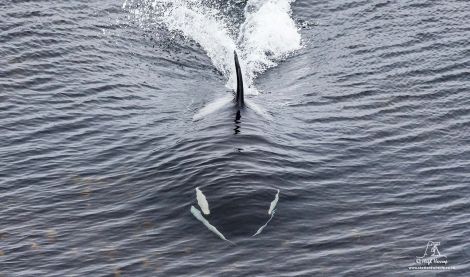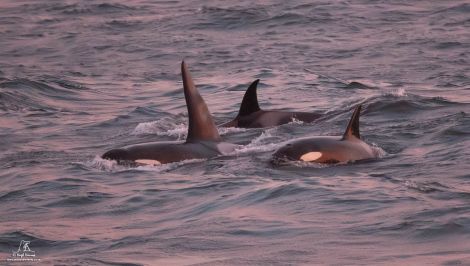Showcases / Have a whale of a time in Shetland
Social media reports of sightings, images and videos of cetaceans from the shoreline is helping to put Shetland on the map as a prime whale-watching destination. This feature has been contributed by VisitScotland.
VISITORS are heading to the northern isles hoping to catch a glimpse of pods of whales after being alerted via social media and associated news stories.
Last summer, Scotland was voted by Wanderlust travel magazine amongst the world’s 12 best locations for whale watching, saying it is best for ‘the possibility of large pods of orca, especially off Shetland…’ Other locations in the top 12 included Mexico, Canada, the Azores and Iceland.
Hugh Harrop, one of Shetland’s top naturalists, co-author of the forthcoming book Europe’s Sea Mammals and owner of the award-winning business Shetland Wildlife, said rather than a sudden increase in whale numbers, it was more likely that the popularity of social media was making it easier to spread the word quickly when pods were spotted.
“We are pretty much seeing the same pods year-on-year but we are also discovering small numbers of ‘new’ pods and individuals known from elsewhere – especially Iceland,” he said.
“Facebook and social media have enabled us to get the word out and reach those that are interested in seeing these animals quickly and efficiently.
“The Shetland Orca Sightings Facebook page, set up to let people find out where orcas can be seen, now has around 15,600 members and I don’t think there is a community in Shetland that doesn’t have a representative on there. Involving the community has worked brilliantly.”
Sightings, videos and photos are posted on the site on a sometimes daily basis and although the period between May and August is the best time to see killer whales (they come inshore to hunt seals) in February, a video of a pod of orcas feeding off Fethaland, at the north tip of Shetland’s mainland, was uploaded to the site and has already had 17.4k views and 107 shares.
Wildlife/bird watching (activities undertaken/attractions visited as part of a trip) is a huge draw for visitors to Scotland. Research has shown that it accounted for 494,000 domestic visits here in 2015, with £187m spend. These visitors spent an average of 5.5 nights per trip and spent £68 per night.
Local accommodation providers can reap the rewards of this interest, as the same research found that visitors to wildlife activities predominantly stay in hotels/motels (33 per cent) or self-catering properties (19 per cent). Those who stay in hotels spend the most per night (£115) and those who camp or stay in a towed caravan stay on average the longest at seven and eight nights respectively.
As whales can often be spotted outwith the traditional tourism season of April to October, this new awareness of land-based sightings can help benefit seasonality in Shetland, as it extends visitors into the shoulder months – often a battle for tourism providers.
As the frequency and ease of whale and dolphin spotting from the land increases, so too do the economic benefits for the local community. Hugh said as the interest in whale watching from the land grew in Shetland, they wanted to involve the whole community.
“I had the owner of a shop telling me they had sold out of ice creams one day and when I asked why, she said it was because of the amount of people out watching a pod of orcas. She said she hadn’t had a day like it for years,” Hugh Harrop said.
Pods of the predators have in the past come in close to hunt at Sumburgh, Gulberwick, Lerwick and South Nesting; and whales were also seen to the east side of the South Mainland around Sandwick and Levenwick, as well as numerous sightings in Lerwick Harbour.
“There was a pod of orcas off Sumburgh Head and there’s no doubt in my mind that we had people travelling to see them after it had appeared on the page. It worked brilliantly for visitors and allowed us to monitor the whales and get some new images as well as promoting eco-tourism to the general public as well as our own client base,” he added.
“When an orca alert goes out, scores of people can see it at the same time and what is also very special is that families with children are involved.
Dr Richard Shucksmith is one of Shetland’s leading wildlife cameramen, specialising in coastal habitats and underwater. He has had several close encounters with whales in Shetland, including one where he filmed a humpback whale whilst snorkelling and another where a pod of orcas come in so close to land that he couldn’t photograph them with his long lens so had to film them on his phone instead.
“There is nothing quite like an orca chase. The excitement, the adrenaline, you always worry whether you’re going to make it or not before they move to an area you cannot follow them, or they move offshore. Social media has been excellent at alerting everyone of a sighting, making it more likely that lots of people get to see the killer whales,” he said.
“Every sighting is exciting and special but there are some that really stick in my mind. My little boy – who was nearly two at the time – woke up at 5am. The night before, there had been sightings of killer whales off Whalsay, so I decided to take a drive to Nesting Bay just on an off-chance.
“I can still see it all in my mind – it was 5.30am and we were driving the coastal road when a six-foot dorsal fin came up just metres off the shoreline, followed by three or four more from that pod. The excitement was unbelievable. Jack got to see the orca, and that was a start of the remarkable day where myself and a colleague (once I had dropped Jack off with his mum) followed the orcas all day, till dark.
“We saw them make over ten seal kills and a lot of the footage shot that day was used in the TV programme screened in January on BBC Scotland, Wild Shetland.”
Hugh added: “Before social media became popular, a coastal walker may have spotted a whale, or a fisherman or someone on a ferry may have seen one out at sea, but they would only tell one person, whereas 10 years later, that pod would’ve been picked up somewhere else and we would’ve had more eye time on them and people can instantly share their sightings online.
“I was guiding a visitor up here in June one year who had booked a three-day photo trip and he was photographing a mother and cub otter just seven or eight metres away. We then heard that there were orcas off Sumburgh Head. Once the otter had moved away without the risk of us disturbing it, it was the fastest run back to the Land Rover ever! If the whales are in certain zones, we can pretty much track where they will be. We can work out which routes they are taking and estimate where they might be by their swimming speeds.”
Steve Mathieson, VisitScotland’s Development Manager for Shetland, said: “Whale watching as a specific activity isn’t something we’ve ever really promoted due to the odds of actually seeing one when you want to. It’s like the Northern Lights – we’re the best place in the UK to see them but it can’t be guaranteed!
“However, enjoying Shetland’s wildlife is a major part of the holiday experience for visitors and offers a big growth potential to Scottish tourism. Earlier this year I was watching a humpback whale from Victoria Pier in Lerwick harbour with some excited German tourists who had just arrived in Shetland – they couldn’t believe their luck!
“Shetland is home to some of the world’s most beautiful creatures which intrigue and fascinate our visitors, including whales, dolphins, otters, puffins and other extensive birdwatching opportunities.
“I think it is fantastic that the creation of a social media page by Hugh to alert people to any sightings has been so successful and has undoubtedly put Shetland firmly on the map as a whale watching destination.”
People are encouraged to spot any sightings of whales, dolphins and porpoises during National Whale and Dolphin Watch week, from 27 July to 4 August. This event gives a general snapshot of what is in the UK’s coastal waters and provides not only important research data but also raises awareness of the importance of conserving the marine environment.
The Hebridean Whale Trail also recently launched, aiming to showcase Scotland’s west coast as a world-class destination for spotting whales, dolphins and porpoises from land, and champion conservation of the Hebrides’ globally important marine wildlife and environment.
The trail, the first of its kind in the UK, is a unique initiative connecting more than 30 top places offering opportunities for land-based sightings of whales, dolphins and porpoises, or showcasing important whale heritage sites that reveal the history of people’s relationships with whales in these communities.
Karl Stevens, Hebridean Whale Trail Manager, said: “Scotland is not a place people really associate with whale sightings but a quarter of the world’s species of whales, dolphins and porpoises have been spotted in our waters.
“A big part of the whale trail is going to be making people more aware of the whales they can see in Scottish waters. The trail encourages people to visit some of the local communities surrounding these sites, perhaps go to the local café for lunch and stay in that place a little longer.”
Become a supporter of Shetland News
Shetland News is asking its many readers to consider start paying for their dose of the latest local news delivered straight to their PC, tablet or mobile phone.
Journalism comes at a price and because that price is not being paid in today’s rapidly changing media world, most publishers - national and local - struggle financially despite very healthy audience figures.
Most online publishers have started charging for access to their websites, others have chosen a different route. Shetland News currently has over 600 supporters who are all making small voluntary financial contributions. All funds go towards covering our cost and improving the service further.
Your contribution will ensure Shetland News can: -
- Bring you the headlines as they happen;
- Stay editorially independent;
- Give a voice to the community;
- Grow site traffic further;
- Research and publish more in-depth news, including more Shetland Lives features.
If you appreciate what we do and feel strongly about impartial local journalism, then please become a supporter of Shetland News by either making a single payment or monthly subscription.
Support us from as little as £3 per month – it only takes a minute to sign up. Thank you.










